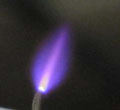Trying to build an effective small recording studio can be a frustrating experience because of acoustical problems. Things just don't seem to sound right. Recordings seem to sound muddy or cloudy. A primary reason for this is the tendency for rooms with small dimensions to have severe coloration in the mid bass or upper low frequency region. Coloration is a result of standing waves or resonances in a room. Unfortunately smaller rooms have dimensions that favor standing waves or resonances that are right in the fundamental range of voice and many musical instruments where our hearing is much more sensitive and critical than at lower frequencies.
Also unfortunate is the mistaken belief that the use of materials such as foam acoustical tiles and fiberglass can solve these coloration problems. The worst coloration problems are caused by frequencies around 300 Hz and below. In smaller rooms the most noticeable build up often occurs between about 100 and 300 Hz. While foam tiles and fiberglass are excellent absorbers at higher frequencies they become increasingly less effective below about 1000 Hz. Often times trying to use foam tiles or fiberglass to cure a bad sounding room actually aggravates the problem and results in a very dead sounding room with a lose of the natural clarity and sparkle of voice and instruments. A very dead room is not a very pleasant recording or listening environment and often seems to require excessive amounts of EQ with the resulting recordings still lacking in clarity and presence.
So how to control coloration without making the room too dead? Bass traps or low frequency absorbers are commonly used in professional recording and broadcast studios and can be constructed for use in small studios. A very effective and easy to build bass trap is the slat-type Helmholtz resonator. These can be designed to absorb the offending frequencies causing coloration problems while at the same time reflecting and diffusing the higher frequencies contributing to a very natural sounding acoustical environment for recording and mixing.
A simple example of a Helmholtz resonator is blowing across a pop bottle to produce a tone. Changing the volume of the airspace within the bottle changes the pitch of the tone. Likewise changing the enclosed volume of the airspace inside the Helmholtz resonator bass trap changes its working frequency.
A slat-type Helmholtz absorber is simply a six sided box with openings or slots on its front side to couple the enclosed volume of the airspace in the box to the air in the room. The depth of the enclosed airspace in the box behind the slots and the width and depth of the slots control the resonant frequency of the bass trap.
Slat-type Helmholtz absorbers are very easy to design. The formula for calculating the absorber's resonant frequency is:
f = 2160 * sqrt ( r / (( d * D ) + ( r + w )))
Where:
f = resonant frequency of the absorber in Hertz (Hz)
d = effective depth of slot in inches (1.2 x the actual thickness of the slat)
D = airspace depth (depth of box behind the slots) in inches
You can use a spread sheet such as Microsoft Excel to model various dimensions and tunings for slat-type Helmholtz absorbers. This can be very useful as you can easily see how changing any dimension changes the tuning of the absorber.
The formula for determining the fundamental frequency of a standing wave for a particular room dimension is:
Where:
fo = Fundamental frequency of the standing wave
V = Velocity of sound (1130 feet per second)
d = Room dimension being considered in feet (length, width, or height)
Other standing waves occur at harmonics of the fundamental frequency - that is 2, 3, and 4 times the fundamental. Thus a room with an 8 foot ceiling has standing waves forming at 70 Hz (the fundamental frequency or first harmonic), 140 Hz (the second harmonic), 210 Hz (the third harmonic) and 280 Hz (the fourth harmonic).
As mentioned earlier, rooms with smaller dimensions often have standing waves or resonance build ups that are very noticeable causing coloration at around 200 Hz or so.
For example, building a box with an airspace depth of 4 inches using wood slats 1/2 inch thick and 2-1/2 wide results in a box tuning of about 240 Hz. In practice it is not usually necessary to be extremely exact with the tuning frequency. Being in the ballpark will often work very well. In fact many slat-type bass traps are designed with slots of varying widths (perhaps plus or minus 1/16 to 1/8 inch of the design center frequency) to cover a wider band of frequencies. Also loosely lining the inside of the box with materials such as fiberglass widens the bandwidth (lowers the Q) of the absorber. Building and mounting multiple units perhaps with slight variations in tuning can also improve the control of coloration. Mounting multiple units throughout a room improves absorption effectiveness and promotes diffusion of higher frequencies.
A more complete explanation of the principles of acoustics mentioned here can be found in Jeff Cooper's book entitled Building A Recording Studio. It is a fairly basic and easy to understand book on acoustics, and it is also very practical and very useful for someone interested in building a small recording studio.


 加好友
加好友  发短信
发短信
 电声工程师
电声工程师
 Post By:2006-10-16 22:59:03 [只看该作者]
Post By:2006-10-16 22:59:03 [只看该作者]




 加好友
加好友  发短信
发短信

 Post By:2006-11-10 12:21:46 [只看该作者]
Post By:2006-11-10 12:21:46 [只看该作者]



 加好友
加好友  发短信
发短信

 Post By:2006-11-22 16:58:29 [只看该作者]
Post By:2006-11-22 16:58:29 [只看该作者]



 加好友
加好友  发短信
发短信

 Post By:2007-1-23 16:43:15 [只看该作者]
Post By:2007-1-23 16:43:15 [只看该作者]



 加好友
加好友  发短信
发短信

 Post By:2007-1-23 16:45:04 [只看该作者]
Post By:2007-1-23 16:45:04 [只看该作者]



 加好友
加好友  发短信
发短信

 Post By:2007-7-26 0:13:28 [只看该作者]
Post By:2007-7-26 0:13:28 [只看该作者]


 加好友
加好友  发短信
发短信

 Post By:2007-8-21 1:39:17 [只看该作者]
Post By:2007-8-21 1:39:17 [只看该作者]
